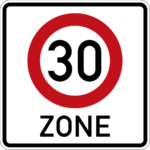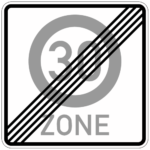Speeding in a 30 Zone
| Limit surpassed by* | Fine | Penalty Points | Suspension | File objection? |
|---|---|---|---|---|
| up to 10 km/h | 30 € | - | - | rather not |
| 11 - 15 km/h | 50 € | - | - | rather not |
| 16 - 20 km/h | 70 € | - | - | rather not |
| 21 - 25 km/h | 115 € | 1 | - | check here |
| 26 - 30 km/h | 180 € | 1 | (1 month)** | check here |
| 31 - 40 km/h | 260 € | 2 | 1 month | check here |
| 41 - 50 km/h | 400 € | 2 | 1 month | check here |
| 51 - 60 km/h | 560 € | 2 | 2 months | check here |
| 61 - 70 km/h | 700 € | 2 | 3 months | check here |
| over 70 km/h | 800 € | 2 | 3 months | check here |
** A driving ban is usually imposed only when there are two speeding violations of 26 km/h or more within 12 months (“Persistent violation of duties”).
The 30-Zone

Many drivers tend to get frustrated when they’re in a hurry and have to pass through a 30 zone that may seem unnecessary at that moment. However, the speed limit serves a purpose and is aimed at protecting residents in certain areas of public transportation. Recently, 30 zones are also being established to reduce environmental pollution. Therefore, motorists who exceed the prescribed maximum speed and get caught by speed cameras should be prepared for significant penalties.
Zones with a maximum speed of 30 km/h are intended to calm traffic and are often found in residential areas or near schools to provide better protection for children on their way to school. Such areas can also be found in nature conservation areas. The first 30 zone in Germany was introduced in 1983 as a pilot project in the Lower Saxony town of Buxtehude. The legal basis for 30 zones is provided by §45 section 1c of the Road Traffic Regulations (StVO).
Speed cameras are frequently used in 30 zones, with a particular emphasis on areas around schools as a preventive measure. To learn more about the penalties for offenses in a 30 zone and other important considerations, continue reading.
What Penalties Apply for Speeding in a 30 Zone?
In Germany, the same regulations that apply to other speeding violations within city limits also apply to exceeding the speed limit in a 30 zone. Whether you’re caught speeding in a 30 zone or a 50 zone, the consequences are the same. Both fines and penalties, including points on your driving record or a driving ban, may be imposed, potentially resulting in significant and long-term consequences.
A minor violation with a speed exceeding the limit by up to 10 km/h results in a fine of 30 euros. However, when driving at a speed of at least 51 km/h in a 30 zone, it is considered a more serious offense, and you’ll receive at least one penalty point. At speeds in excess of 56 km/h in a 30-zone offenders may also become targets for a driving ban.
If, instead of the prescribed 30 km/h, you are caught driving at 101 km/h in a 30 zone, you’ll be required to pay a fine of 800 euros. Additionally, you will receive 2 penalty points on your driver’s record in Flensburg and a three-month driving ban.
Penalty examples for speeding in a 30 zone
All penalties for speeding violations in 30 km/h zones as defined in the current fine catalogue can be found here for your reference. The same penalties are applied as in 50 km/h zones, as there is no distinction between the two speed zones in the fine catalogue. Up to an amount of 70 euros, it is still considered a warning fine, meaning that neither points nor a driving ban are added.
Warning Fines:
- Exceeding the speed limit by up to 10 km/h: 30 euros warning fine
- Exceeding the speed limit by 11 to 15 km/h: 50 euros warning fine
Fines, Points, and Driving Bans:
- Exceeding the speed limit by 16 to 20 km/h: 70 euros fine
- Exceeding the speed limit by 21 to 25 km/h: 115 euros fine, 1 point, No driving ban
- Exceeding the speed limit by 26 to 30 km/h: 180 euros fine, 1 point, possibly 1-month driving ban
- Exceeding the speed limit by 31 to 40 km/h: 260 euros fine, 2 points, 1-month driving ban
- Exceeding the speed limit by 41 to 50 km/h: 400 euros fine, 2 points, 1-month driving ban
- Exceeding the speed limit by 51 to 60 km/h: 560 euros fine, 2 points, 2-month driving ban
- Exceeding the speed limit by 61 to 70 km/h: 700 euros fine, 2 points, 3-month driving ban
- Exceeding the speed limit by more than 70 km/h: 800 euros fine, 2 points, 3-month driving ban
Why and where do 30 km/h zones exist?
The reasons for and locations of 30 km/h zones are defined in §45 of the German Road Traffic Regulations (StVO). There are various reasons for reducing speed limits in specific areas of road traffic. Three significant reasons for establishing a 30 km/h zone are:
- Enhancing road safety
- Reducing emissions, both from exhaust gases and noise
- Improving the quality of the residential environment
30 km/h zones are primarily found in residential areas. The purpose of these zones is to encourage motorists to drive at a slower speed to protect the residents. This serves the dual purpose of reducing noise pollution and minimizing emissions, enhancing the overall quality of life in these specific areas. Additionally, these zones are intended to contribute to accident prevention. In the vicinity of schools, 30 km/h zones also aim to protect children, who are often inexperienced road users. Furthermore, these areas typically have a high number of pedestrians and cyclists.
30 km/h Zones Exist Only Within City Limits
According to the regulations in the Road Traffic Regulations (Straßenverkehrsordnung), 30 km/h zones are only established within closed urban areas and not in rural areas. These zones are primarily found in “residential areas and areas with high pedestrian and bicycle traffic density, as well as a high demand for pedestrian crossings.” The decision to implement 30 km/h zones is made jointly by the traffic authorities and local municipalities. These zones cannot be located on federal, state, or county roads or other priority roads. Furthermore, the zone should only encompass roads with intersections and junctions that are not regulated by traffic lights. The same applies to roads with lane demarcations, guide lines, and mandatory bicycle paths.
Signage for 30 km/h Zones


Signage for 30 km/h Zones
A 30 km/h zone is initiated by a traffic sign featuring a black “30” encircled in red, beneath which the word “Zone” is displayed. The end of the zone is also marked. This sign is structured similarly to the one at the beginning, with gray lettering and a gray circle, both crossed by diagonal black stripes. Additionally, a 30 km/h zone may be indicated by road markings, which can vary in appearance. However, the sign is essential; without it, the road markings hold no significance.
Right-of-Way Regulations in the 30 km/h Zone
In a 30 km/h zone, the standard right-of-way rule of “yield to the right” as per Paragraph 8, Clause 1, Sentence 1 of the Road Traffic Regulations applies. An exception exists for 30 km/h zones with traffic lights installed before November 1, 2000. In these cases, the right-of-way rule is overridden by the traffic lights.
Parking in the 30 km/h Zone
There is no general prohibition on parking in the 30 km/h zone. Parking is permitted unless expressly prohibited by no-parking or no-stopping signs. Motorists must adhere to the general regulations for stopping and parking, such as parking only in the direction of travel and within designated parking bays.
Caught Speeding in the 30 km/h Zone?
Since 30 km/h zones typically follow 50 km/h zones within urban areas, many drivers tend to exceed the prescribed speed limit in 30 km/h zones. Penalties and sanctions for speeding in both 50 km/h and 30 km/h zones within urban areas are the same. Depending on the extent of the speed violation, drivers may face points on their license and the possibility of a driving ban.
Is it Worth Contesting a Fine?
If you were caught speeding in a 30 km/h zone and received a fine, many fine notices have errors, making it worth to object to the fine. For instance, if you are not the person visible in the speed camera photo but someone else is, you can submit a written objection within two weeks. However, some errors may be difficult to detect on your own or may require substantial effort to address, and in such cases, it may be advisable to consult with an attorney.
Conclusion
Aside from the fact that nobody likes to be caught speeding, drivers should adhere to the speed limits in these designated zones. Since the “yield to the right” rule generally applies in 30 km/h zones, it is not advisable to drive faster, as this would require more abrupt braking when following the right of way. In these zones with increased pedestrian and bicycle traffic, drivers can also respond more quickly to a hazardous situation when they maintain the speed limit. Nevertheless, even when obeying the prescribed speed limit in 30 km/h zones, drivers should remain particularly vigilant, as unexpected traffic situations can occur relatively frequently in these areas.
